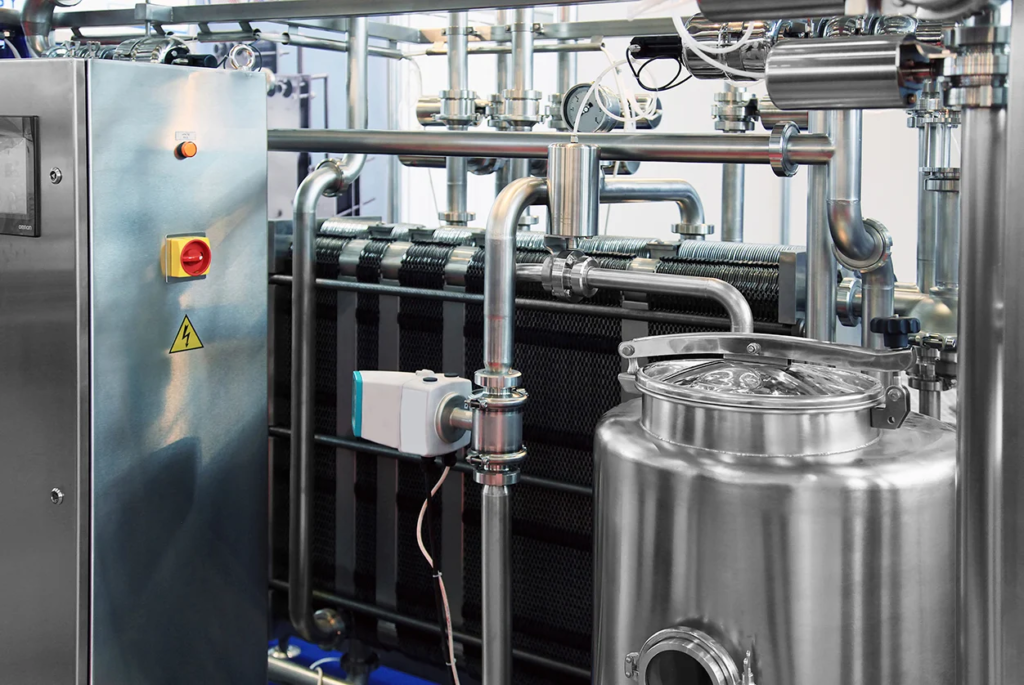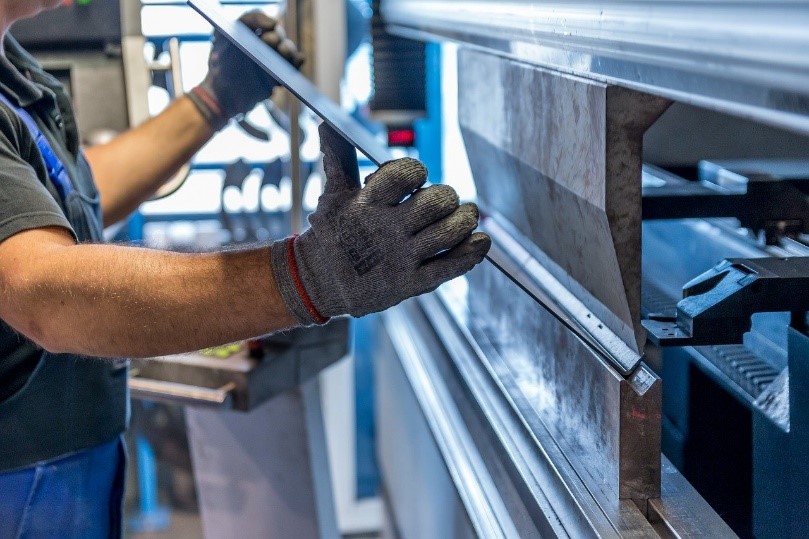In the Food and Beverages industry stainless steel (SS) is the most preferred material for food contact surfaces, ever wonder why??
First and foremost, any material, that comes in contact with food must be corrosion resistant and inert in nature. When there is no reaction between the material and the food, not only does the material remain pristine, but so will be the food, uncontaminated by metallic constituents or corrosion products.
In India, FSSAI requires that the food contact material, under normal conditions of use, should not transfer their constituents to foods that could endanger human health. The material should not bring about an unacceptable change in the composition of the food or any changes in the organoleptic properties. On both these parameters, SS scores high marks. Not all SS is equal and the most widely used is 304 because of its great properties.
The resistance to corrosion comes from an invisible, protective film of chromium-rich oxide which forms spontaneously in the presence of oxygen or oxygenated water in the alloy containing 10.5% or more of chromium. Even if the film gets damaged, it rapidly repairs itself once the source of the damage is removed and the surface is exposed to oxygen again.
In addition to the inertness and corrosion resistance, stainless steel has many more properties which make it an ideal choice for food processing plant and equipment. It is easy to make smooth, non-absorbent surfaces from SS and the inherent hardness helps it keep that way. Any rough surface makes the cleaning process difficult and will allow the growth of biofilms which can present a hygiene hazard. SS can also withstand a wide range of temperatures from cooking to freezing, and resist thermal shock- a term used to describe the rapid and significant change of temperature in a short period of time.
The reliability and longevity of SS contribute significantly to its life cycle costs. Even when a piece of SS has reached the end of its useful life, the SS itself hasn’t. The popularity of SS in the food industry is due to a combination of practicality and aesthetics.
Which Stainless Steel??
SS is steel that contains a controlled amount of chromium. SS is not a single material but a combination of over 200 iron-carbon-chromium alloys. SS are steels that contain a maximum of 1.2% carbon and a min of 10.5% chromium. Depending on the operating conditions and requirements some grades of SS may suffer corrosion, so a grade that has more chromium or which has additions of other elements such as nickel, molybdenum, nitrogen, and copper, may be required because of its greater resistance to a particular environment or to a particular type of corrosion.
The simplest stainless steel is the iron-carbon-chromium alloys and these fall under 2 groups. The first group is the martensitic SS which contains only about 13% chromium, but they have a high level of carbon (even up to 1%) which makes them difficult to form and weld. This also makes them very hard and strong and heat treatment can make them harder. AISI 440c contains 1% carbon and is extremely hard and is used in rolling contact stainless bearings and knife blades. A minimum of 0.45% carbon is used for superior kitchen knives which will retain their sharpness even after prolonged use.
The other iron-carbon-chromium group is known as the ferritic SS and these will typically contain about 17% chromium and about 0.05% carbon. These groups are called so as they are magnetic. They are commonly used for appliances like dishwashers, refrigerators, and pans. SS 430 has acceptable corrosion resistance and is relatively inexpensive. The challenge with this is that it is less easily formed or welded than the austenitic SS (304). For applications demanding to weld, grades like 441 which has an addition of titanium and /or niobium are recommended.

With the challenges of the above 2 groups, on fabrication, the addition of nickel offers valuable advantages. There are 3 groups of iron-carbon-chromium-nickel SS. The first group is known as the austenitic SS with 8 – 12% nickel content which makes them easy to form and yet tough. This also means they are ductile, and they can be easily roll-formed. Their 18% chromium gives them a very good defense against general corrosion. They are the most commonly used SS in the food and beverage industries.
SS 304 is an austenitic SS that contains approx. 0.05% carbon, 18% chromium, and a min. of 8% nickel. It is widely used in the food and beverage industry from milk tankers, kitchen sinks to brewing vessels. SS 316 is another version of 304 with about 2% molybdenum added and it is particularly resistant to high levels of chloride and Sulphur dioxide in the operating environment. This makes it suitable for the storage of salty foods, white wines, and aggressive media such as pectin in jam making. The super -austenitic steels are tolerant of extremely aggressive conditions. High levels of chromium, nickel, molybdenum, and nitrogen and a low carbon content confer to austenitic SS, superior or corrosion resistance in a wide array of aggressive conditions.
There is another group which is the duplex steels. These have high levels of chromium – 22% in grade -(2205)- 23% in grade (2304) and about 3% molybdenum in case of grade (2205). These grades are used in very corrosive environments such as mustard and vinegar making, cheese, or fish-canning plants. Duplex steels are expensive and have a resistance to general corrosion similar to austenitic SS but much higher mechanical strength. They also have a better resistance to stress corrosion cracking than austenitic SS and corrosion resistance superior to the 316 SS.
The third group is the precipitation-hardening SS. The cost of this group of SS is high which has a combination of iron-carbon-chromium-nickel but provides good corrosion resistance out of the austenitic grades with the excellent properties of the martensitic steels. A steel such as ASIS 630 has additions of copper (improves its resistance to reducing acids) and niobium (to help to reduce corrosions at welds)
Surface Finish and Design
The food contact surface needs to be smooth, to avoid any food residue build-up, which is durable enough to resist cracking, chipping, flaking, and abrasion and should not only resist the process soils but also be easily cleaned and disinfected. The rougher is the surface the more easily matter such as food will stick to it. This food will harbor micro-organisms that, if not removed, may multiply and cross-contaminate the next batch of food.

The design of equipment intended for the processing or storage of foods and beverages are stringent. The machinery/equipment must be designed and constructed which meet the hygiene standard which will help reduce corrosion, which is the reason the SS is reinforced by hygienic design. Apart from the corrosion, the design of the food contact surface should be in a way, to avoid any risk of infection, sickness, or contagion as well as be properly operated, cleaned, and maintained. If a design leaves crevices between components, eg, at joints or bends or under the bolts, these will not only retain process soils but also be difficult to clean. Cleaning agents may also be trapped in these crevices. The more smoothly the food product can flow through the equipment, the less danger there is of it being trapped in a dead area which can be difficult to clean leading to all physical, chemical, and microbial contamination.
To Sum it up
Stainless Steel is the preferred material in the food and beverage industry due to its inert nature, ease of fabrication, durability, and ability to recycle. Using the correct grade of steel for an application, designing an equipment with hygiene in mind, and prepared with care will ensure that all the 3 hazards are avoided from contamination.

Author: Sarika Agarwal is the Managing Director and Principal Consultant at Food Safety Works. She is an expert at international standards like FSSC22000, BRC, and FSMA. Over her career spanning 15+ years, she has helped clients with effective food safety management systems.



